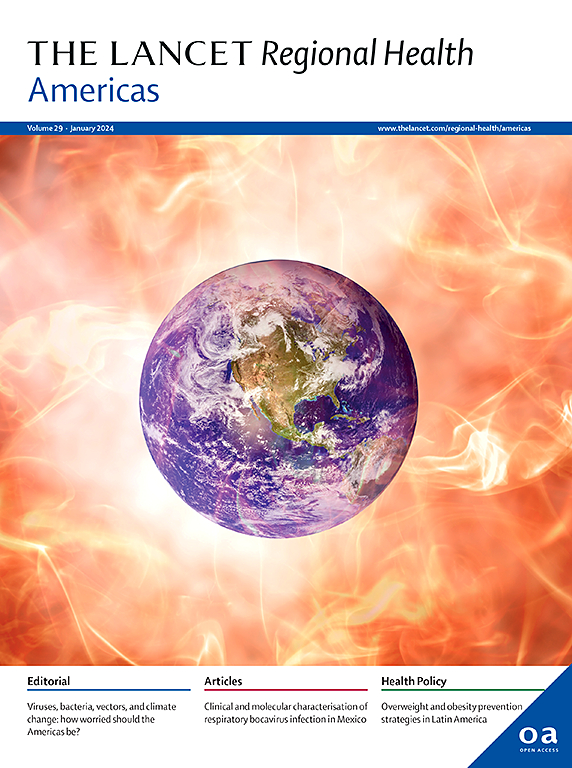拉丁美洲急性缺血性卒中的成本评估:一项多中心研究。
IF 7
Q1 HEALTH CARE SCIENCES & SERVICES
引用次数: 0
摘要
背景:目前的文献强调了拉丁美洲精确中风成本数据的差距。本研究使用时间驱动作业成本法(TDABC)测量拉丁美洲急性缺血性卒中护理相关的实际成本。研究结果旨在为该地区采用基于价值的医疗保健(VBHC)战略奠定坚实的基础。方法:该研究是一项观察性、多中心、国际分析,对2021年12月至2022年12月住院的急性缺血性卒中患者的直接成本和结局进行分析。研究人员分析了来自阿根廷、巴西、智利、哥伦比亚、哥斯达黎加、墨西哥、秘鲁和乌拉圭中风中心的数据。费用按国家分层。基于改良Rankin量表(mRS 0-2)的有利结果、临床风险水平和治疗干预措施等因素被纳入分析。使用广义估计方程(GEE)模型来评估临床变量与每位患者总成本的关系。研究结果:共纳入1106例患者。在这些患者中,74%单独接受药物治疗,18%接受静脉溶栓(IVT), 4%接受机械取栓(MT), 3%接受IVT + MT联合治疗。每位患者的平均费用为12,203美元(SD $ 15,055美元),49%获得良好的功能结果。与单独的药物治疗相比,MT的成本高出3.1倍,每位患者的增量成本为20,418澳元(p)解释:我们的研究强调了拉丁美洲医疗保健服务中卒中成本的显着差异,受治疗可及性、患者预后和临床风险概况变化的影响。这些发现为制定卫生政策决策以增强该地区卒中护理的长期可持续性提供了重要见解。资助:该项目获得了世界中风组织和勃林格殷格翰公司(BI) IS 0135-0352的资助。本文章由计算机程序翻译,如有差异,请以英文原文为准。
Cost evaluation of acute ischemic stroke in Latin America: a multicentric study
Background
Current literature highlights a gap in precise stroke cost data for Latin America. This study measures the real costs associated with acute ischemic stroke care in Latin America using Time–Driven Activity-Based Costing (TDABC). The findings aim to lay a solid foundation for adopting value-based healthcare (VBHC) strategies in the region.
Methods
The study is an observational, multicenter, international analysis of direct costs and outcomes for patients hospitalised with acute ischemic stroke from December 2021 to December 2022. Data from stroke centres in Argentina, Brazil, Chile, Colombia, Costa Rica, Mexico, Peru, and Uruguay were analysed. Costs were stratified by country. Factors such as favourable outcomes based on the modified Rankin Scale (mRS 0–2), clinical risk levels, and treatment interventions were considered for the analysis. Generalized Estimating Equation (GEE) models were utilised to assess the relationship of clinical variables with the total cost per patient.
Findings
A total of 1106 patients were included in the study. Among these patients, 74% received medical treatment alone, 18% received intravenous thrombolysis (IVT), 4% underwent mechanical thrombectomy (MT), and 3% received combined IVT plus MT. The mean cost per patient was I$ 12,203 (SD I$ 15,055), with 49% achieving a favourable functional outcome. Compared to medical treatment alone, MT incurred costs 3.1 times higher, with an incremental cost of I$ 20,418 per patient (p < 0.0001). Across all countries, costs increased according to patients' clinical risk and treatment options, with length of hospital stay emerging as the primary cost driver.
Interpretation
Our study highlights significant disparities in stroke costs across healthcare services in Latin America, influenced by variations in treatment accessibility, patient outcomes, and clinical risk profiles. These findings offer essential insights for shaping health policy decisions to enhance the long-term sustainability of stroke care in the region.
Funding
The project received funding from the World Stroke Organization and Boehringer Ingelheim (BI) IS 0135-0352.
求助全文
通过发布文献求助,成功后即可免费获取论文全文。
去求助
来源期刊

Lancet Regional Health-Americas
Multiple-
CiteScore
8.00
自引率
0.00%
发文量
0
期刊介绍:
The Lancet Regional Health – Americas, an open-access journal, contributes to The Lancet's global initiative by focusing on health-care quality and access in the Americas. It aims to advance clinical practice and health policy in the region, promoting better health outcomes. The journal publishes high-quality original research advocating change or shedding light on clinical practice and health policy. It welcomes submissions on various regional health topics, including infectious diseases, non-communicable diseases, child and adolescent health, maternal and reproductive health, emergency care, health policy, and health equity.
 求助内容:
求助内容: 应助结果提醒方式:
应助结果提醒方式:


